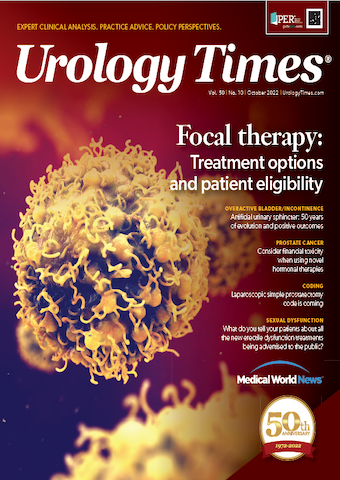Publication
Article
Urology Times Journal
Long-term data support MRI-guided TULSA for localized prostate cancer
Author(s):
MRI-guided transurethral ultrasound ablation (TULSA) provided durable disease control with low toxicity at 3 years’ follow-up in men with localized prostate cancer, according to pivotal findings shared at the 2022 Annual Meeting of the North Central Section of the AUA.1
At 3 years, the median PSA decreased 95% from 6.3 ng/mL to 0.26 ng/mL nadir, stable at 0.70 ng/ml. At 1 year, the median prostate volume decreased from 37 to 3 cc.
In an interview with Urology Times, study author Michael Koch, MD, chair of the Department of Urology at the Indiana University School of Medicine, provided some background on the TULSA technique.
“There are a number of different techniques to ablate prostate tissue…This technique is a probe that goes in a man's urethra and then emits sound waves that go from inside the prostate towards the outside. And it's done in an MRI machine that can measure tissue temperature. The procedure is done until you drive the tissue temperature up high enough to coagulate all the protein in the tissue and kill the tissue. The biggest advantage of this technique is that because the sound waves are coming from inside and going outwards, it doesn't destroy anything beyond the prostate, at least in theory.”
The study included 115 men with localized prostate cancer (≤T2b, PSA ≤15 ng/ ml, Grade Group [GG] 1-2) enrolled at 13 centers in the United States and Europe. All patients received whole-gland ablation. The primary study end point was PSA reduction and safety at 1 year. Secondary end points included volume reduction, MRI, and 10-core biopsy at 1 year, as well as quality-of-life, PSA, and salvage to 3 years.
At 1 year, GG2 disease had been eliminated in 79% (54/68) of men. At 3 years, 87% (100) of men did not require additional treatment, while 13% (15) had received salvage therapy.
Koch said that 11 of the patients on the study were treated at his institution and that his outcomes matched the overall study population with 82% (9) of patients not requiring further therapy and 18% (2) of patients receiving salvage treatment at 3 years. Further, at 1 year, GG2 disease had been eliminated in 80% (8) of the 10 patients treated at his institution who had GG2 at baseline.
Of note, Koch said the study was able to establish that if TULSA fails, it is feasible to perform post-TULSA salvage radical prostatectomy, which he said has been safely done at his institution.
Regarding safety, 9 (8%) men in the overall study population experienced grade 3 adverse events (AEs), all of which were resolved by 1 year.
“There were some early side effects, most of them were infection. When you coagulate the entire prostate, the patient can't urinate for a while, so they have to have a catheter. And with that they get bacteria in the urine and some of them had infections in the bladder, fevers, they can get infections in the testicles, we saw some of that. Not a lot of it, we saw some of that,” said Koch.
Regarding potential long-term AEs, 92% of men maintained pad-free continence and erections sufficient for penetration (IIEFQ2≥2) were maintained by 75% (69/92) and 76% (38/50) of men at 1 and 3 years, respectively. Koch commented that, in general, both the continence and erectile function rates were superior to those with surgery.
Now that the efficacy and safety of TULSA have been established in this study, there is an ongoing randomized trial comparing TULSA with radical prostatectomy in patients with intermediate-risk prostate cancer.
Reference
1. Koch M, Gardner T, Bahler C, et al. MRI-Guided Transurethral Ultrasound Ablation in Men With Localized Prostate Cancer: Three-Year Follow-Up and Feasibility of Post-Ablation Salvage Prostatectomy. Presented at: 96th Annual Meeting of the North Central Section of the AUA. August 28-31, 2022; Chicago, Illinois. Poster 106.































